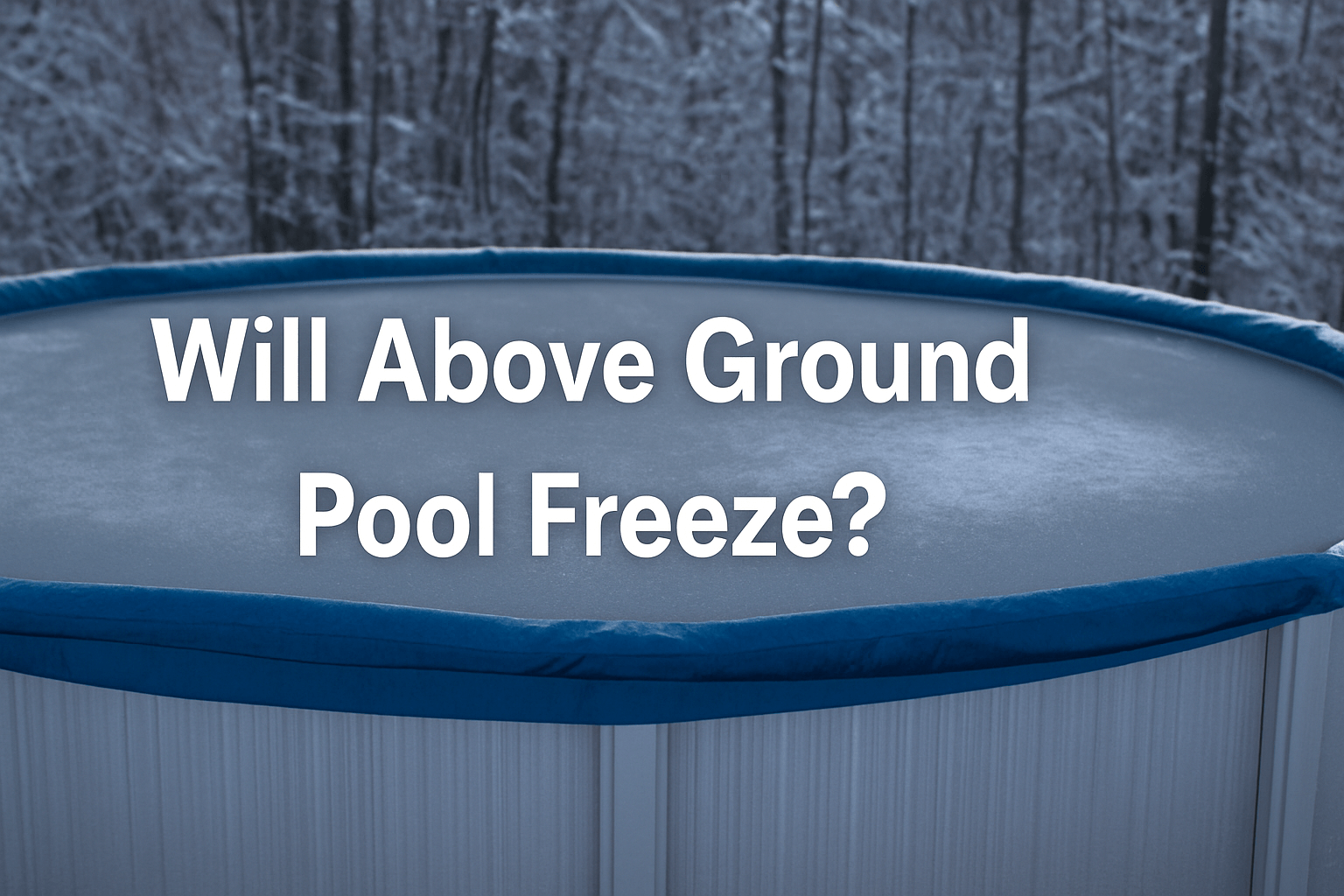
Will Above Ground Pool Freeze?
Worried your above ground pool might turn into an ice rink this winter?
Short answer: yes, it can freeze — especially if you don’t prep it properly.
We remember our first winter with a pool. We thought tossing a cover on it would be enough.
Spoiler alert: it wasn’t. We learned the hard way.
Now we know how to protect even the best above ground pools through freezing temperatures.
Keep reading, and we’ll show you exactly how to keep yours safe and sound.
The Science of Freezing Water and Its Impact
Water Expansion: The Primary Threat
Here’s the deal: when water freezes, it expands.
That might sound harmless, but inside your pool, it’s like a silent wrecking ball.
It pushes outwards — on the liner, the walls, the fittings.
Too much pressure, and things start to split, crack, or buckle.
How Prolonged Sub-Zero Temperatures Affect Pool Water
In mild weather, your pool might just get a thin layer of surface ice.
But if it’s freezing for days on end, that ice builds up.
It gets thicker.
It creeps into the pipes, the pump, and the filter housing.
Once it sets in, the damage starts quietly — and gets worse fast.
Factors Increasing Freezing Risk (Stagnant Water, Lack of Winterisation)
Still water is ice’s best friend. If your pump’s off and the chemistry’s out of whack, your pool’s a sitting duck.
Skip winterising? You’re practically inviting frost in for tea.
And poor maintenance? That’s just rolling out the red carpet for damage.

The Reality: Why Freezing is a Major Concern for AGPs
Above Ground Pools' Vulnerability Compared to In-Ground Pools
In-ground pools have a secret weapon: insulation.
The earth around them keeps water warmer for longer.
Above ground pools? They’ve got cold air attacking from every angle.
That means they freeze quicker, and they freeze harder.
The Potential for Complete Freezing in Very Cold Climates
If you're up north or in a rural spot where it really gets icy, your pool can freeze solid.
Not just the top — the whole thing.
We’ve seen it happen.
It turns into a giant, icy drum — not ideal for swimming, or structural integrity.
Ice Formation on the Surface and Within Plumbing
The scary part isn’t the ice you see.
It’s the ice sneaking into your return lines and pump housing.
That’s where pipes split, filters crack, and fittings give up.
The Damage Caused When Above Ground Pools Freeze
Structural Damage to the Pool Itself
Liner Tears and Cracks from Expanding Ice
A stretched or torn liner isn’t just ugly — it leaks.
Ice presses outward, and your liner can only stretch so far.
Once it splits, you’re looking at draining, drying, patching… or replacing.
Buckling or Warping of Pool Walls and Uprights
Metal uprights and thin steel walls aren’t built for ice expansion.
One hard freeze and they can bend like a cheap tent pole.
We’ve seen pools bow out like a pudding tin in the oven.
Stress on Top Rails and Other Frame Components
Top rails take a beating in winter.
If ice presses upwards, it shifts everything out of alignment.
By spring, the whole thing can be twisted — and not in a fun way.

Catastrophic Equipment Failure
Burst Pipes and Plumbing Lines
Water expands when it freezes — and pipes don’t like that.
Even a few drops left inside can cause a crack.
Next time you fire up the pump? Boom — water everywhere.
Cracked Pump Housings, Filter Tanks, and Heater Components
Pumps and filters are expensive.
So when frozen water swells inside and splits them open, it stings.
We once saw a cracked heater spill water the minute it turned on.
A £700 lesson in proper winter prep.
Damage to Skimmer and Return Fittings
Skimmers are notorious weak spots.
They fill with water, freeze solid, and split right down the middle.
If you're not using skimmer guards, you're rolling the dice.
Hidden and Long-Term Problems
Compromised Structural Integrity Leading to Future Leaks
Even if nothing explodes, the freeze can cause micro-cracks.
These lead to slow leaks, rust spots, and bigger problems down the line.
Sometimes you don’t notice until summer — when it’s too late.
Costly Repairs and Replacements
New liner? Costly.
New pump? Even worse.
A full rebuild? Let’s not even go there.
The cost of not winterising adds up fast.

Preventing Freezing: Essential Winterisation for Above Ground Pools
Comprehensive Water Preparation
Cleaning and Balancing Pool Chemistry
Start by giving your pool a proper clean.
Leaves, dirt, bugs — get them out.
Then test your water.
Make sure your pH, alkalinity, and calcium levels are all in range:
-
pH: 7.2–7.8
-
Alkalinity: 80–120 ppm
-
Calcium Hardness: 175–225 ppm
This helps prevent scaling, corrosion, and nasty surprises in spring.
Adding Winterizing Chemicals (Algaecide, Stain Preventer)
Add an algaecide to stop green slime from waking up early.
Toss in a stain preventer to keep metals in check.
And if you haven’t already — give the water a good shock.
Protecting the Pool's Water and Structure
Lowering the Water Level (Below Skimmer and Returns)
Drain the water just below the skimmer.
This helps avoid freezing damage where it hurts most.
Don’t go too low though — you still want water supporting the walls.
Utilizing Air Pillows to Absorb Ice Expansion
Inflate one or two air pillows and tie them to the middle of the pool.
They act like shock absorbers when the ice expands.
No air pillows? Some people use empty, sealed milk jugs.
Not perfect, but better than nothing.
Securing a Durable Winter Cover
A tough winter cover is a must.
It keeps the cold out and debris off.
Here’s a quick material breakdown:
| Material | Durability | Maintenance |
|---|---|---|
| Polypropylene | High | Low |
| Polyethylene | Medium | Medium |
| Vinyl | Low | High |
Tie it down tight. Add cover clips or water bags if needed.
Safeguarding Plumbing and Equipment
Draining All Water from Lines, Pump, Filter, and Heater
Water left inside = cracked components by January.
Drain every pipe, every hose, every chamber.
Don’t forget the pump basket or filter tank.
Blowing Out Remaining Water from Pipes (Using a Blower/Shop Vac)
Use a shop vac or blower to push out the last bit of water.
It’s a small step that saves big headaches.
Focus on return lines, skimmers, and suction ports.
Removing and Storing Sensitive Equipment Indoors
Take your pump, filter, heater, and any non-winter bits indoors.
Keep them dry, off the ground, and away from frost.
Label hoses and fittings to make setup easier next year.
Installing Winterising Plugs and Skimmer Guards
Once lines are drained, plug them up.
Install skimmer guards or Gizzmos to absorb pressure.
They’re cheap, easy, and could save your skimmer from splitting.
Have you checked out our other posts?
Can You Leave Above Ground Pools Up In The Winter?
Do You Drain Above Ground Pools In The Winter?
Do You Empty An Above-Ground Pool Every Year?



Leave a comment